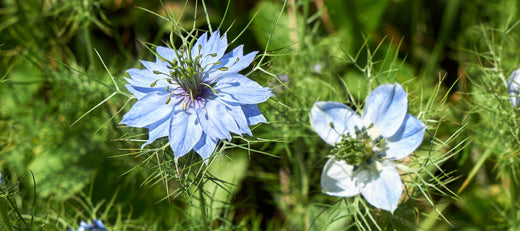In continuing our company mission to provide beneficial seeds to customers to help them become more self-reliant, we have focused on increasing our selections of herbs and flowers known for their natural medicinal properties. One of the seeds we added this year was Nigella sativa, commonly known as Black Cumin, Black Caraway, Habbatus sauda, or Kalonji.

Black cumin should not be confused with Cumin (Cuminum cyminum), an herbaceous plant with seeds well known for its use as an aromatic spice.
Black cumin seeds, harvested from seed pods, have been traditionally used both as a spice and natural remedy for thousands of years earning it the name “the herb from heaven”. The oil from black cumin seeds is popularly used as a topical remedy, and it is a very exotic-looking plant due to its unusual blossoms and seed pods. Let’s learn more about this unique and beneficial herb.
Origins of Black Cumin
Nigella sativa is just one of 18 species of plants in the family Ranunculaceae. It is characterized by feathery, fern-like foliage, pale blue to white blossoms with tendril-like stamens. Some varieties of Nigella are grown purely as ornamental plants. One popular variety, Nigella damascena, commonly known as Love-in-a-Mist, has been grown in English cottage gardens since the Elizabethan era. Nigella hispanica is a stunning ornamental variety with blue flowers, red stamens, and grey leaves.
Nigella sativa is native to Africa and Southwest Asia, but it is commonly grown in India, Pakistan, Turkey, and other Mediterranean countries. The highest quality seeds are known to come from Egypt because of its ideal climate for growing this plant. There are records of black cumin seeds being found in the tombs of the pharaohs. It has been mentioned in the Old Testament of the Bible as well as literature about Chinese, Indian, Arab, and Islamic medicine.
Health Benefits of Black Cumin

Due to the long history of black cumin as a healing herb, some sources call Nigella sativa one of the most significant medical plants in history. The value of black cumin is thought to come largely due to its antioxidant properties. Nigella sativa seeds are high in thymoquinone, a compound known to have anti-inflammatory properties making it useful for treating diabetes and improving cardiac health. Black cumin has been used to treat fever, ailments of the respiratory system, headache, digestive issues, back pain, and inflammation. Studies have shown it to be antimicrobial, antibacterial, antiviral, antifungal, antihypertensive, as well as gastroprotective, among other uses. With a list like that, it is no surprise that it is considered a cure-all.
The seeds of the plant are the part used for medicinal purposes. One can eat the seeds, and black seed oil and paste can be used topically as a skin inflammation treatment and for hair care. Black seed oil also works as an insect repellent.
How to Grow Black Cumin
Choose a nice sunny spot and sow your black cumin seeds after the first frost. In warmer zones, you may sow seeds in fall for spring blooms.
This herb is not terribly picky about soil, but it should be well-draining. Sow seeds about 8 to 10 inches apart on the surface of your soil and just barely cover them because they need light to germinate. Plants will grow to about 8-10 inches tall with light feathery foliage and pale blue to white flowers.
Water regularly, especially during dry spells to promote more growth. You should start to see blooms about 90 days after planting. For continuous blooms, sow seeds every 3 to 5 weeks. Additional fertilizer is not generally needed. Nigella sativa is resistant to most pests and diseases.
Although this is an annual plant, it self-seeds very well and can spread. If you would like to keep your black cumin plants confined, remove the blooms before they can go to seed.
Harvesting Black Cumin Seeds

If you want to take advantage of the flavor and benefits of black cumin seed, allow the seed pods to dry on the plant. They will turn brown and start to crack open. That is how you will know it is time to harvest them.
Cut the stems with seed pods off with scissors or garden shears and put the heads upside down in a paper bag so you don’t lose any seeds. Tie the bag shut and hang it to dry. The seed pods are attractive and look great in flower arrangements.
Remove the seeds from the pods and allow them to fully dry. You can store them in an airtight package for future planting or use them in cooking. They are crunchy and have a spicy flavor that is great on bread, salads, soups, or yogurt. Toast the seeds first to release their volatile oils and enhance the flavor.
Nigella seeds can be ground and mixed with water to make a gel that serves as an egg substitute. They can also be taken as a health supplement, but be sure to consult with your physician before using them for any medical treatment.
Enhance Your Home Apothecary & Garden
With all of the health benefits and medicinal uses, Nigella sativa is a valuable addition to your survival garden. Use it for flavor or its anti-oxidant properties. In addition, it is an attractive plant that will please pollinators and enhance the beauty of your garden.
























